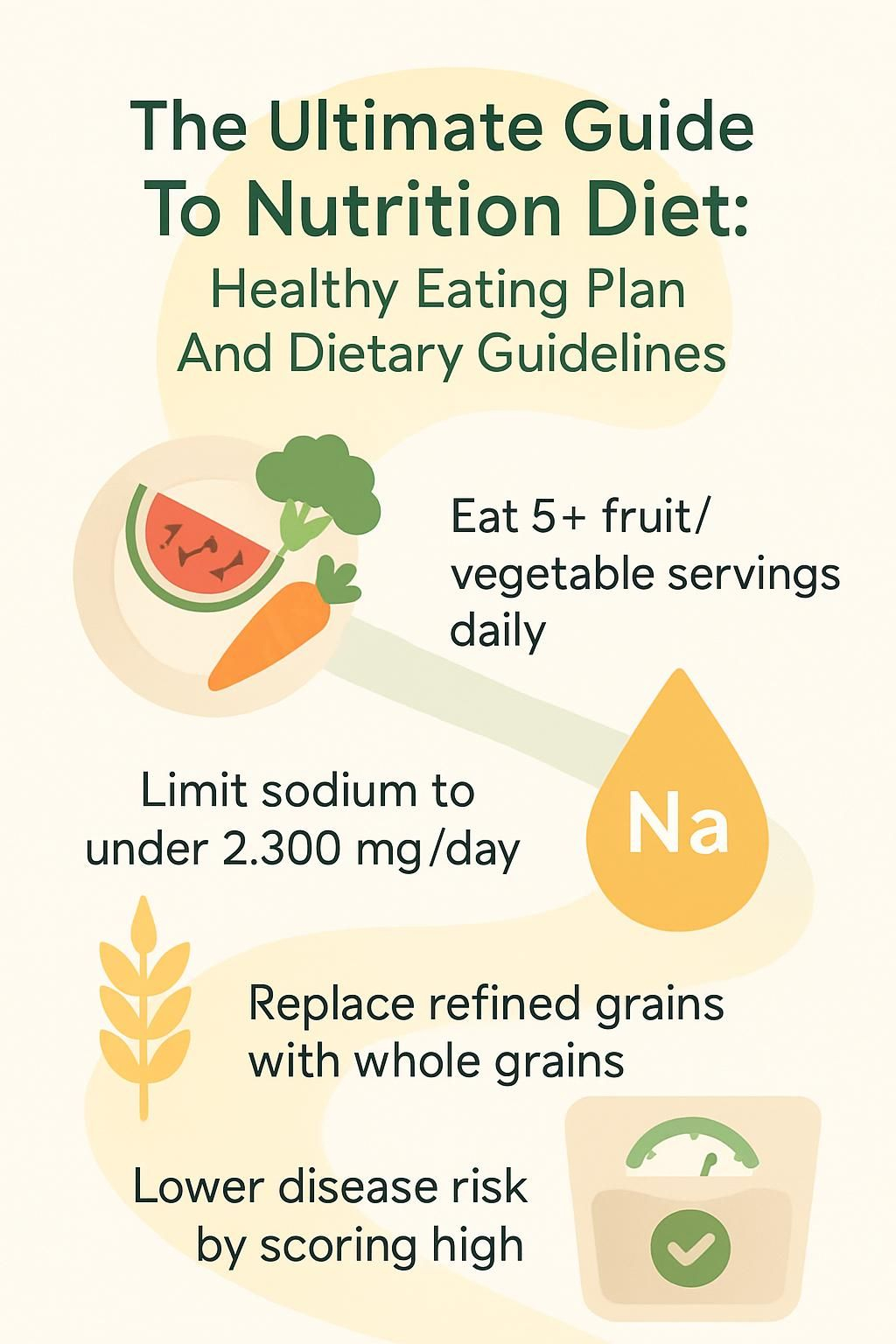The Ultimate Guide To Nutrition Diet: Healthy Eating Plan And Dietary Guidelines
Our Nutrition Assistant AI Suite will transform your body. You will lose fat, get toned, and build muscle. Gain confidence and optimal health.
If you feel unsure about what to eat for steady health, you are not alone. A healthy diet can lower your risk of heart disease, obesity, and high blood pressure. This guide gives you clear steps based on trusted dietary guidelines, including the Dietary Guidelines for Americans. Small food choices each day can add up to stronger health over time.
This article shows you how to build balanced plates, plan smart portions, and tailor meals to your needs. You will also learn simple ways to cut salt, sugar, and unhealthy fat without losing flavor. Keep reading to turn nutrition knowledge into daily habits you can keep.
Key Takeaways
- Following the Healthy Eating Plate and U.S. guidelines, eating at least five servings of fruits and vegetables daily is linked to a much lower risk of heart disease.
- Harvard research shows higher Healthy Eating Index scores relate to lower risks for major chronic diseases in men and women.
- Replacing refined grains with whole grains like brown rice or oats helps with weight control, improves fiber intake, and supports healthy cholesterol and blood pressure.
- Keep sodium below 2,300 mg per day, and choose foods low in saturated fat and added sugars to support cardiovascular health.
- Customize your plan based on age, activity level, medical conditions, or cultural foods. Use resources like Nutrition.gov, the Eatwell Guide, or a registered dietitian.

What Are the Basics of Nutrition?

Nutrition means giving your body the mix of nutrients it needs for growth, energy, and repair. These include vitamins, minerals, carbohydrates, protein, dietary fiber, healthy fats, and antioxidants. Each one plays a role, from supporting your immune system to fueling your muscles.
Aim for at least five servings of fruits and vegetables daily. Choose lean proteins like poultry, fish, beans, or tofu to build and repair tissue. Whole grains such as oats, quinoa, or brown rice provide steady energy and more fiber than refined grains.
Use simple guides like MyPlate to build balanced meals from all food groups. Pick fat-free or low-fat dairy to meet calcium needs with less saturated fat. Healthy fats from avocados, nuts, seeds, olive oil, and canola oil support brain function and hormone balance.
Choosing nutrient-dense foods most of the time helps you maintain a healthy weight. Processed snacks usually add extra sodium, sugar, and calories without many nutrients.
A well-balanced plate is your most dependable tool for lifelong health.
How Does a Balanced Diet Impact Your Health?
Eating a balanced diet improves your odds of staying healthy across your lifespan. Large cohort studies from Harvard link quality eating patterns with lower risks of heart disease, stroke, and early death.
Men who scored high on the Healthy Eating Index had lower risks for major diseases over time compared with those who scored low. Women who followed core dietary guidelines also saw a meaningful drop in chronic disease risk. Choosing whole grains, fruits, vegetables, and lean proteins, and cutting added sugars and unhealthy fats, supports heart and metabolic health.
Filling your plate with colorful produce and whole grains can reduce cardiovascular problems. Many people notice better energy during daily activity after swapping refined grains and processed meats for whole grains and lean proteins.
These habits support public health goals set by the Department of Agriculture and help with weight management by reducing empty calories and extra sodium.
Key Components of a Healthy Eating Plan
A strong plan covers what to eat, how much to eat, and how to build meals you enjoy. You will see quick wins when you start with the basics, then keep it consistent.
Why Are Fruits and Vegetables Important?
Fruits and vegetables should make up just over one third of what you eat daily. Aim for at least five portions each day. Fresh, frozen, canned, dried, and 100 percent juice can all count, but limit juice to one small glass due to sugar.
One portion equals about 80 grams of fresh fruit or vegetables, three heaped tablespoons of cooked vegetables, or 150 milliliters of juice or smoothie, counted once per day. The Healthy Eating Plate focuses on a wide variety of vegetables and does not count fries or potatoes as vegetables in this model.
Different colors often mean different nutrients. Building color on your plate makes it easier to meet your vitamin and mineral needs and supports a healthy weight.
What Are the Benefits of Whole Grains?
Whole grains include the entire grain kernel. They provide complex carbohydrates, fiber, and B vitamins. The type of carbohydrate matters as much as the amount, which is why whole grains beat refined grains for health.
Choose whole wheat bread, brown rice, oatmeal, or quinoa. At least one third of your food can come from starchy choices like pasta or corn, but pick whole grain versions most often. Whole grains help with fullness, digestion, cholesterol, and heart health.
A bowl of oatmeal at breakfast can carry you through the morning with steady energy. The United States Department of Agriculture suggests making at least half your grains whole to support healthy cholesterol and blood pressure.
Switching from white bread to whole wheat toast made my meals more filling and reduced afternoon cravings.
Which Foods Are Good Sources of Lean Proteins?
Choose fish, skinless poultry, beans, lentils, tofu, and nuts. Select lean cuts of meat if you eat meat. Enjoy fish at least twice a week, including one serving of oily fish like salmon or mackerel for omega 3 fatty acids, which support heart and brain health.
Beans and lentils offer fiber and protein with little saturated fat. Eggs are a complete protein and can fit in many meals. Limit processed meats like bacon and deli meats because they tend to be high in sodium and preservatives.
Up next, pick healthy fats to round out your plate.
What Types of Healthy Fats Should You Eat?
Use oils rich in unsaturated fats such as olive, canola, and soybean oil for cooking and dressings. These fats help improve cholesterol levels. Spreads made from sunflower or soybean oils are better choices than butter for most people.
Keep an eye on portion sizes because all fats have 9 calories per gram. Avoid trans fat in packaged snacks and baked goods, and limit saturated fat from fatty meats and full fat dairy. A simple swap from butter to canola oil can make a noticeable difference in your cholesterol numbers within a few months.
What Are Dairy Products and Their Alternatives?
Milk, yogurt, and cheese provide protein, calcium, and often vitamin D, which support bones and teeth. Include one or two servings per day. Choose fat free or low fat options with little added sugar.
If you do not drink cow’s milk, try fortified soy milk or soy yogurt for a similar protein level. Almond and oat beverages can add variety, but many have less protein. Look for options fortified with calcium and vitamin D.
Simple switches, like moving from whole milk to low fat milk in coffee, help you meet nutrient goals while keeping saturated fat in check.
Why Is Staying Hydrated Important?
Water plays a key role in blood flow, digestion, and temperature control. Most people do well with about 6 to 8 glasses daily. Choose water as your main beverage. Unsweetened tea or coffee can also fit.
Sugary drinks add calories with little nutrition. Keep juice to one small glass per day because of its natural sugars. Sports drinks can help during long, hard workouts, but water usually works for everyday needs.
| Beverage | Nutrition Notes | Suggested Amount |
|---|---|---|
| Water | Hydration with zero calories | 6 to 8 glasses per day |
| Tea or coffee | Best without added sugar | Enjoy in moderation |
| 100% juice | High in natural sugar | One small glass per day |
| Sugary drinks | High calories, few nutrients | Limit or avoid |
Essential Guidelines for a Nutritious Diet
Following a few core rules makes daily choices easier. These steps guide shopping, cooking, and portion sizes in a practical way.
How to Follow National Dietary Guidelines?
National guidelines offer science based advice for long term health. Use these steps to apply them at home.
- Read the latest guidance on Nutrition.gov and MyPlate to learn recommended food group patterns.
- Fill half your plate with fruits and vegetables at most meals. Aim for at least five portions each day.
- Choose higher fiber starchy foods such as whole grains to support digestion and steady energy.
- Pick lean proteins like fish, beans, lentils, and nuts. Limit processed meats that add saturated fat and sodium.
- Add dairy or fortified alternatives to meet calcium and vitamin D needs.
- Use small amounts of unsaturated oils and spreads, such as olive or sunflower oil.
- Match your daily calorie needs to your age, sex, and activity level to maintain a healthy weight.
- Cut back on salt from packaged foods. Check labels and choose lower sodium options.
- Use simple tools like the Healthy Eating Index or Plate visuals to review your meal quality.
- Skip fad diet products that promise quick results. Aim for variety across food groups instead.
- Try a one week food log. Many people discover they need more fiber and fewer sweets after tracking.
Why Embrace a Diverse Food Selection?
Eating a wide range of foods helps cover your nutrient needs. The Healthy Eating Plate highlights vegetables and fruits in many colors, whole grains, lean proteins like fish or beans, dairy or alternatives, and healthy oils.
Potatoes and fries are not counted as vegetables in this model because they act like starches. A diverse mix supports heart health and lowers the chance of nutrient gaps. Many families find that colorful salads topped with seeds or nuts make dinner both tasty and balanced.
How to Limit Unhealthy Fats and Sugars?
Too much saturated fat, trans fat, and added sugar can raise disease risk. Use this checklist to make smarter picks.
- Read labels and limit saturated fat. Choose lean meats and low fat dairy.
- Cook with olive or canola oil, and use small amounts.
- Keep total fat reasonable because it is high in calories.
- Avoid trans fat in packaged snacks and baked goods.
- Swap sugary drinks for water or unsweetened tea.
- Cut back on cakes, cookies, and candy. Enjoy them less often.
- Cook at home more often so you control sugar and oil.
- Choose whole grains instead of refined flour items.
- Snack on fresh fruit or a small handful of nuts for fiber and healthy fat.
These habits meet your body’s needs while lowering diet related risks.
What Are Ways to Reduce Sodium Intake?
High sodium can raise blood pressure and the risk of heart disease or stroke. Try these steps to cut back.
- Check labels and choose items with less than 140 mg sodium per serving when possible.
- Cook more at home using fresh foods. Restaurant meals often contain a lot of salt.
- Season with herbs, spices, garlic, lemon, or vinegar instead of salt.
- Limit processed meats such as bacon, ham, sausage, and deli slices.
- Pick water or unsweetened drinks. Some beverages include hidden sodium.
- Skip seasoning mixes that list salt near the top of the ingredient list.
- Use less salt at the table. Your taste buds adjust over time.
- Compare similar products, like bread or cheese, because sodium can vary by brand.
- Review DASH diet tips at Nutrition.gov for a heart smart template rich in fruits, vegetables, and low fat dairy.
- Many people see blood pressure improvements within weeks after making simple swaps.
Reducing daily sodium supports heart health and makes room for more flavorful ingredients.
How to Choose Nutrient-Rich Foods?
Nutrient dense foods give you more vitamins, minerals, and fiber per calorie. Build your meals around these options.
- Pick whole grains such as brown rice, oats, or whole wheat bread.
- Fill half your plate with vegetables and fruits. Do not count potatoes as a vegetable in this model.
- Choose lean proteins like beans, fish, tofu, or skinless poultry.
- Include healthy fats from nuts, seeds, avocados, and olive oil.
- Drink water instead of sugar sweetened beverages.
- Use low fat dairy or fortified plant milks for calcium and vitamin D.
- Limit high sodium foods. Read labels and cook more at home.
- Aim for variety every day to cover essential nutrients.
- Favor fresh or minimally processed foods for more fiber and fewer additives.
- Watch for added sugars on labels. Keep snacks simple, like yogurt with fruit or a small trail mix.
These steps align with the Healthy Eating Plate, which prioritizes food quality over quantity.
How to Manage Meal Portions Effectively?
Portion control helps you stay at a healthy weight without counting every calorie. Use visuals and a few tools to keep it simple.
- Follow the Healthy Eating Plate: half vegetables and fruits, one quarter whole grains, one quarter lean protein.
- Measure portions with kitchen scales or cups when learning what a serving looks like.
- Use the Eatwell Guide visuals to grasp food group proportions.
- Choose smaller plates and bowls to avoid overeating.
- Read labels and compare calories, fiber, sodium, and sugar per serving.
- Pre portion snacks like chips or sweets instead of using the whole bag.
- Track meals in a simple diary or app to spot patterns.
- Know common examples, such as 150 ml juice or 30 g dried fruit as a snack.
- Split restaurant meals, or save half for later.
- Shop with a food group list so your cart mirrors your plate.
- Favor fiber rich foods like whole grains and vegetables to feel full on fewer calories.
How to Customize Your Nutrition Strategy
Your needs depend on age, activity level, health conditions, and culture. Adjust the plan so it fits your life and routines.
How to Tailor Your Diet to Age and Activity Levels?
Nutrition needs shift as you grow and as your daily movement changes. Use these steps to match food with fuel needs.
- For everyone over age two, follow the Eatwell Guide proportions.
- Increase calories if you are very active. Many active teens need 2,000 to 3,200 calories per day.
- Children under two need higher fat dairy and nutrient dense foods to support brain development.
- As you age, prioritize protein to support muscle. Include lean meats, eggs, dairy, beans, and tofu.
- Older adults may need fewer calories but more calcium and vitamin D.
- Hydrate during physical activity and in hot weather. Water works best for most people.
- Adjust serving sizes to match training or physically demanding jobs.
- Focus on fiber from fruits, vegetables, and whole grains for digestion at every life stage.
- Time meals around workouts to fuel before and recover after.
- Track weight, energy, and strength to guide small adjustments.
Flexible planning helps you meet health goals through changing seasons of life.
What Dietary Considerations Are There for Health Issues?
Health conditions often call for specific nutrition plans. Get support to keep changes safe and effective.
- Talk with a healthcare professional before major diet changes if you have diabetes, heart disease, high blood pressure, or food allergies.
- Reduce sodium if your blood pressure runs high. A common target is below 2,300 mg per day.
- Limit saturated fat and added sugar if you are at risk for heart disease or diabetes. Choose lean chicken or fish more often than fatty red meats.
- Use Nutrition.gov for guidance on hypertension, diabetes, or obesity. Plans usually center on whole grains, fruits, and vegetables.
- Ask your clinic about weight management programs if you want structured support for weight loss.
- Choose nutrient dense foods tailored to your needs, such as lactose free or fortified dairy alternatives, or plant proteins for vegetarian meals.
- Practice portion control. Measured servings can prevent overeating, which may worsen some conditions.
Medical disclaimer: This content is educational and not a substitute for personalized medical advice.
How to Adjust Your Diet for Cultural Food Preferences?
You can honor cultural traditions and still meet nutrition goals. Use your favorite flavors while balancing food groups.
- Use traditional ingredients with less saturated fat, sodium, and added sugars.
- Keep food group proportions similar even in stir fries, tacos, curries, or stews.
- Rely on plant proteins such as beans or lentils if common in your cuisine.
- Pick whole grain versions of breads, rice, and noodles when possible.
- Choose healthier cooking methods, such as grilling, steaming, roasting, or baking.
- Season with herbs and spices to boost flavor without extra salt.
- Include dairy or fortified alternatives that match your preferences and calcium needs.
- Drink water with meals. Unsweetened cultural teas can also fit well.
- Plan portions that respect shared plate customs while balancing the overall meal.
- Lighten family recipes by cutting sugar or salt, then build flavor with spices and fresh herbs.
- Seek advice from dietitians familiar with your heritage if you want more tailored support.
When Should You Consult Nutrition Professionals?
See a registered dietitian or healthcare professional if you have chronic conditions or unique dietary needs. Get help for diabetes, high blood pressure, food allergies, digestive issues, or weight management.
Expert guidance turns general advice into a safe, personal plan. Small changes make a big difference, and a professional can help you choose the right first step.
Building a Healthy Eating Plate
A balanced plate makes every meal a chance to meet your nutrition goals. Think of it as a simple map for your day.
How to Balance Food Group Proportions?
Use The Plate visual as a quick guide. These proportions work for most adults and teens.
- Fill just over one third of your plate with fruits and vegetables. Aim for color variety.
- Use just over one third for starchy foods such as whole grain bread, brown rice, or whole wheat pasta.
- Leave space for dairy or fortified alternatives. Choose low fat milk, plain yogurt, or fortified soy drinks.
- Include a portion of beans, lentils, fish, eggs, or lean meat for protein.
- Use small amounts of healthy oils. Olive oil is a smart swap for butter.
- Keep all fats in check, since they contain more than twice the calories per gram compared to protein or carbs.
- Drink water with meals to support digestion and overall health.
Many families report fewer between meal snacks after building plates this way.
How to Ensure Nutrient Diversity in Meals?
Balance is the first step. Diversity is the next. Variety helps you cover vitamins, minerals, and antioxidants across the week.
- Fill half your plate with colorful produce, like spinach, carrots, red peppers, berries, oranges, and broccoli.
- Choose whole grains such as brown rice, quinoa, or oats instead of refined grains.
- Rotate protein sources across the week. Include fish, beans or lentils, skinless poultry, eggs, or nuts.
- Use healthy fats, like olive or canola oil, to help absorb vitamins A, D, E, and K.
- Pick low fat dairy or calcium fortified alternatives such as soy or almond beverages.
- Drink water regularly rather than sugary drinks.
- Combine food groups in single meals. For example, try chicken stir fry with broccoli over brown rice and a sprinkle of sesame seeds.
- Plan ahead with a shopping list that highlights variety. This prevents last minute choices that lack key nutrients.
What Are Everyday Meal Preparation Tips?
Good prep habits make healthy eating easier on busy days. A little planning saves time and reduces stress.
- Use the Healthy Eating Plate to guide each meal.
- Cook with olive or canola oil instead of butter or lard.
- Keep fresh, frozen, or canned fruits and vegetables ready. Aim for five servings a day.
- Choose whole grains. Leave potato skins on to boost fiber.
- Plan weekly menus with all food groups so shopping is simpler.
- Wash produce when you get home, so it is ready to use.
- Prepare lean proteins and favor grilling, baking, or steaming.
- Pre portion ingredients and snacks to manage serving sizes.
- Label leftovers with dates to make lunch packing easy.
- Keep water nearby during prep and at meals.
- Rotate recipes and season with herbs and spices to keep meals interesting without extra salt.
What Are Nutritional Needs at Different Life Stages?
Your nutrition needs change across childhood, adulthood, and later years. Adjusting portions and nutrients can help you feel your best.
What Are Children’s Nutritional Needs?
Children need a balanced mix of nutrients for growth and development. After age two, they can follow the same food group proportions as adults, with smaller serving sizes.
Energy needs rise with age and activity. Serve fruits, vegetables, whole grains, dairy or fortified alternatives, and lean proteins at each meal. Offer water often, not sugary drinks. Many families find kids try more foods when they help build their own plates with colorful choices.
What Are Adult Dietary Requirements?
Adults need enough energy to support work, activity, and recovery. Follow the Healthy Eating Plate or the Eatwell Guide to build meals with half fruits and vegetables, one quarter whole grains, and one quarter lean protein.
Limit foods high in saturated fat, salt, and added sugar. Physical activity supports weight control and heart health. Many adults notice higher energy after trading soda for water at lunch for a couple of weeks.
What Are Senior Nutrition Guidelines?
As you age, calorie needs often fall while nutrient needs rise. Focus on nutrient density, which means more vitamins and minerals per bite. Many older adults need extra calcium and vitamin D for bone health.
Use the Plate model to balance food groups. Keep saturated fat, added sugar, and sodium low to reduce chronic disease risk. Reliable tools on Nutrition.gov can help you plan simple, satisfying meals.
What Are the Common Myths About Healthy Eating?
Myths can make eating well feel confusing. Evidence helps you sort facts from clever marketing claims.
What Is the Truth About Fad Diets?
Fad diets often focus on quick fixes instead of long term health. Many cut whole food groups and can lead to nutrient gaps. Large studies show balanced patterns, like the Healthy Eating Plate and similar models, relate to better outcomes than restrictive plans.
One major study of tens of thousands of women found that a pattern rich in fruits, vegetables, whole grains, and healthy fats linked with lower rates of heart disease compared with low fat diets alone. Balanced nutrition supports steady energy and better health without extreme rules.
What Should You Know About Nutrition Claims?
Some labels use terms like low fat
or high fiber
to sell products. These claims can mislead if you do not read the full nutrition label. Compare claims against trusted sources such as Nutrition.gov, Harvard’s Healthy Eating Plate, and USDA tools like MyPlate.
Educational use of Plate visuals is allowed with proper credit, but be cautious with commercial messages. Focus on the full nutrient picture, not just one front of pack claim.
What Are the Benefits of a Balanced Nutrition Plan?
A balanced plan supports your energy, lowers disease risk, and helps your gut and brain work well. The benefits show up in daily life, from better focus to improved workouts.
How Does Nutrition Boost Energy Levels?
Whole grains like brown rice, oats, and whole wheat bread release glucose slowly. This steadier fuel curve helps you avoid crashes. Healthy fats from olive oil, avocados, nuts, and seeds offer long lasting energy for your brain and hormones.
Lean proteins repair muscle after activity. Hydration matters too, so aim for 6 to 8 glasses of fluids each day. Sugary drinks can spike and crash your energy, so keep them rare.
How Can Diet Lower Chronic Disease Risks?
Eating more fruits and vegetables, along with whole grains and lean proteins, is linked with lower risk of heart disease, stroke, and some cancers. Research shows that people who follow healthy eating patterns have fewer major chronic diseases than those who do not.
Limiting saturated fat and sodium helps maintain healthy cholesterol and blood pressure. Families often see improvements after a few months of adding vegetables and choosing lean proteins at most dinners.
How Does Nutrition Promote Digestive Wellness?
Fiber supports gut health by helping food move through your system. Whole grains, fruits, vegetables, beans, and lentils are all rich in fiber. Nuts add fiber too, but keep portions small because they are calorie dense.
Cutting back on heavily processed foods protects the gut from low fiber filler and additives. Drinking enough water, around 6 to 8 glasses daily, also supports regularity and comfort.
How Does Diet Support Mental Health?
Balanced meals provide vitamins, minerals, antioxidants, and healthy fats that support brain function and mood. Omega 3 fats from salmon and walnuts are especially helpful for brain health. Too much sugar and unhealthy fat can make energy and focus swing.
Pair good nutrition with regular physical activity for added benefits. Many people notice fewer low energy days after eating more whole foods and staying hydrated.
How to Plan Meals Effectively?
Meal planning helps you hit your nutrient targets and reduces last minute takeout. A simple plan saves money and time during busy weeks.
What Are Ideas for Balanced Meals?
Balanced meals include several food groups at once. Use this checklist at breakfast, lunch, and dinner.
- Aim for just over one third fruits and vegetables on your plate.
- Fill another third with whole grains like brown rice, whole wheat pasta, or quinoa.
- Include a lean protein such as chicken breast, beans, eggs, tofu, or fish.
- Add small amounts of healthy fat, like avocado, olive oil, or a few nuts.
- Choose low fat dairy or fortified alternatives for calcium.
- Drink water with every meal.
- Use MyPlate visuals to divide portions at home.
- Limit high fat, high salt, and sugary items to occasional treats.
- Test kid friendly options like oatmeal waffles made with whole wheat flour and oats.
- Rotate ingredients across the week to cover more nutrients and keep meals interesting.
Many families feel more energized all afternoon after adding extra vegetables and swapping white bread for whole grains.
What Are Strategies for Weekly Meal Prepping?
Prepping a few items each week can keep your plan on track. Structure makes it easier to eat well during stressful days.
- Plan a grocery list around all food groups and healthy oils.
- Batch cook staples like brown rice, roasted vegetables, grilled chicken, or beans.
- Store meals in portioned containers that follow Plate guidelines.
- Cook with olive or canola oil instead of butter.
- Rotate food groups to maintain variety and cover nutrients.
- Prepare core ingredients on Sundays to save time on weekdays.
- Freeze extra soups, stews, or casseroles for quick meals.
- Keep easy fruit like apples or oranges for grab and go snacks.
- Track what you prep to reduce waste and avoid duplicates.
- Prep at least three full meals at once so you have a backup plan.
These steps make a nutrition plan more practical and sustainable for busy households.
How to Choose Nutritious Snacks?
Smart snacks keep energy steady between meals and prevent overeating later. Pair fiber with protein for the best results.
- Choose fruits and vegetables, like carrot sticks or apple slices.
- Avoid sugary drinks and candy that spike blood sugar.
- Pick whole grain crackers or popcorn for more fiber.
- Add protein with nuts, seeds, yogurt, or cheese sticks.
- Limit highly processed snacks that are salty or sugary.
- Use seasonal produce to keep flavors fresh and interesting.
- Favor fiber rich choices like edamame or air popped popcorn.
- Drink water with snacks to stay hydrated and alert.
What Is Heart-Healthy Eating?
Heart healthy eating builds your plate around plants, whole grains, and healthy fats. Think of these choices as daily maintenance for your arteries.
How Can Diet Promote Heart Health?
Fill half your plate with colorful fruits and vegetables. Choose whole grains like brown rice instead of refined grains. Include lean proteins such as fish, poultry, or beans. Use olive oil or a small handful of nuts for healthy fats that support arteries.
Cut back on fried foods and processed meats to lower saturated fat and sodium. These steps can help improve cholesterol and blood pressure over time.
What Is an Overview of the DASH Diet?
The DASH Diet, short for Dietary Approaches to Stop Hypertension, is built around fruits, vegetables, whole grains, and lean proteins. It also limits sodium to help lower blood pressure.
Choose brown rice, whole wheat bread, beans, nuts, fish, and skinless poultry. Favor olive oil and avocados for healthy fats. Pair the plan with regular physical activity to support weight management and heart health.
Conclusion
Creating a healthy eating plan starts with the basics, then builds into a routine. Use the Healthy Eating Plate to fill most of your plate with fruits, vegetables, lean proteins, and whole grains. Choose healthy oils like olive or canola, limit butter and processed snacks, and make water your main beverage.
Small daily changes can raise energy and well being. Evidence based dietary guidelines give you a simple map you can follow at any age. If you have medical concerns, seek advice from a clinician or registered dietitian for a plan that fits your needs.
Sources: Dietary Guidelines for Americans 2020 to 2025, Harvard T.H. Chan School of Public Health Healthy Eating Plate and related cohort studies.
FAQs
1. What is a nutrition diet and how does it support health?
A nutrition diet includes balanced meals with essential nutrients like vitamins, minerals, proteins, carbohydrates, and healthy fats. Research shows that following dietary guidelines lowers the risk of chronic diseases such as heart disease and diabetes (Centers for Disease Control and Prevention). For example, after switching to a meal plan rich in vegetables and whole grains, I noticed improved energy levels within weeks.
2. How can someone create a healthy eating plan using dietary guidelines?
Start by choosing foods from all food groups: fruits, vegetables, lean meats or plant-based proteins, dairy products or alternatives, and whole grains. The Dietary Guidelines for Americans recommend limiting added sugars to less than 10 percent of daily calories (U.S. Department of Agriculture). Planning meals ahead helps maintain variety while meeting nutritional needs.
3. Which foods should be limited according to evidence-based dietary recommendations?
Limit processed snacks high in sodium; sugary drinks; red meat; saturated fats; and refined grains. Studies link these foods with higher risks of obesity and cardiovascular problems (Harvard T.H. Chan School of Public Health). Swapping soda for water made my own transition easier while reducing sugar intake.
4. Why are data-driven choices important in building an effective nutrition diet?
Data-driven choices use scientific research to guide food selection based on nutrient content tables or statistics about health outcomes linked to certain diets. This approach ensures each meal supports long-term wellness goals rather than relying on trends without proven benefits.
Summary: A well-structured nutrition diet follows clear dietary guidelines supported by credible sources; uses diverse food groups; limits unhealthy options backed by research findings; relies on data for informed decisions; and often leads to noticeable improvements in overall well-being when applied consistently.







